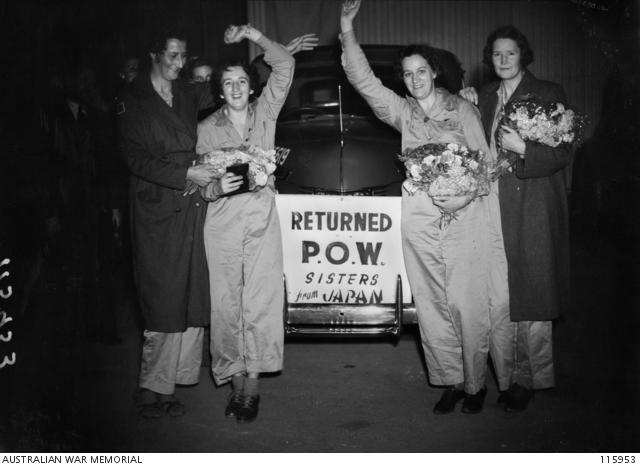Dreaming of sponge cake in Yokohama

Fried shrimps and scallops, ham “a la King” and lemon sponge: these were the dishes that six Australian Army nurses would dream of while they were held captive in Japan during the Second World War.
Instead, the prisoners received a monotonous diet consisting mostly of rice and soya bean soup, and stew with questionable pieces of meat. On the eighth day of each month – known as “degradation” or “humiliation” day – the meagre vegetables that were issued were thrown into a cesspit and the women made to retrieve them; occasionally they were made to eat scraps from a pig bucket.
The nurses’ ordeal, which was to last three years and seven months, began 70 years ago when they surrendered to the Japanese after the invasion of Rabaul on 23 January 1942. Rabaul was the administrative capital of Australia’s Mandated Territory of New Guinea. It had a strategically important, deep-water harbour and airfields that were well-positioned for reconnaissance and bombing sorties over the Japanese naval bases in the Caroline Islands. But few resources were allocated to the protection of the garrison, and the men who tried gallantly to protect it from attack were overwhelmed by a much larger invading force.
The Australian army nurses were mostly country girls who had sailed from Sydney on the converted troopship Zealandia in April 1941. The nurses were the only servicewomen on the island and served with the 2/10th Field Ambulance, which consisted of two doctors and 20 male orderlies.
The army hospital in Rabaul had been evacuated on 22 January and transferred to the Roman Catholic mission at Vunapope. The army doctors didn’t stay on and took with them the ambulances, most of the medical supplies and the orderlies. The head nurse, Sister Kathleen Parker, and an Anglican chaplain surrendered on behalf of the hospital when the Japanese arrived.
The nurses were made to stand for hours in the blazing sun with Japanese machine-guns trained on them. That day the Japanese killed about 20 patients, as well as the chaplain. The army nurses expected to be killed too; instead they were imprisoned in a convent within the mission until July 1942, along with a small number of missionary and administrative nurses and one civilian woman. Some Australian soldiers were also imprisoned in the mission.
In early July the nurses and other internees – including the Australian soldiers -- were taken by ship to Yokohama, Japan. The women spent most of the next two years under guard in the Yokohama Amateur Rowing Club, not allowed to write to their families. At first, the conditions were tolerable: they had clean toilets and cold showers were always available; hot baths were occasionally allowed. There were ping-pong sets, badminton and cards, and during the warmer months they swam in the club pool. But conditions declined after the first year in captivity: the women were regularly slapped and occasionally they were lined up at gunpoint. Red Cross officials were stopped from visiting them. They suffered greatly in the extreme cold of the winter months: their bed coverings were flimsy and heating within the building was poor or non-existent, so to stay warm they slept two to a bed.
Food was always on their minds, and a recipe book compiled by Sister Eileen Callaghan and held at the Australian War Memorial reveals just what they desired: cheese dishes, hearty roasts, fresh salads, luscious desserts, and cakes.
Nurse Daisy Keast recalled that after her release, her first letter home to her parents demanded that her first meal when she arrived home be roast pork and steamed date pudding.
“That’s all we thought about and talked about,” she said. “My family said we never talked to them at all, all we talked about was food.”
The women were moved in April 1944 to a farmhouse at Totsuka, about 50 kilometres from Yokohama and with a view of Mount Fuji. The house had no heating or showers so they washed from buckets. They were made dig air-raid trenches for the Japanese, and in winter had to shovel paths in the snow. They grew weaker from hunger and suffered deficiency diseases such as beri-beri.
The women had scant news from the outside world, but by 1945 they could tell the war was going badly for the Japanese. They watched the bombing raids over Yokohama and Tokyo. On 17 August, 1945, the internees were told that peace had been declared. The women were free, but afraid of reprisals, they remained in the compound. Food suddenly improved, a doctor visited and gave them medicine, and they also received coats to cover their tattered nurses’ uniforms.
On 31 August, after three years and seven months of imprisonment, two of the army nurses intercepted an American convoy and were finally rescued from Totsuka. They were flown to Okinawa Island and then to Manila. They were among the first prisoners of war to arrive home, most of them arriving in Australia on 13 September 1945. Sister Callaghan, who had contracted tuberculosis and received no treatment, arrived back in Australia one month later. She died in March 1954 from continuing problems related to the disease.
The nurses had survived because of a determination to not let the Japanese defeat them. “If we had given up we wouldn’t have come back, it’s as simple as that,” said Sister Marjory Anderson. “If we gave up hope we’d have just died.”
Sources and further reading
Catherine Kenny, Captives : Australian army nurses in Japanese prison camps (University of Queensland Press, 1986)
Second World War Official Histories, Volume VI – The New Guinea Offensives (1st edition, 1961)
Rupert Goodman, Our War Nurses: The History of the Royal Australian Army Nursing Corps 1902-1988 (Boolarong Publications, 1988)